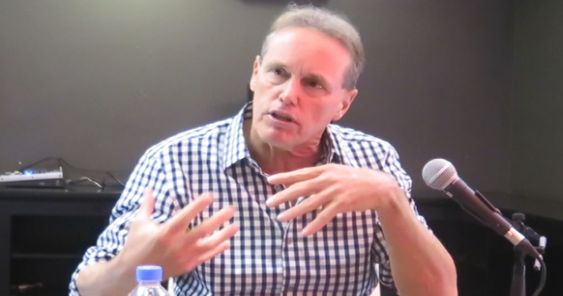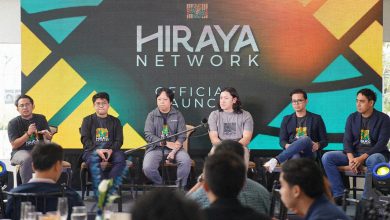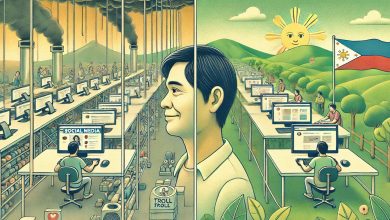MANILA – John Merrifield has seen many things in his life. In an illustrious advertising career that included stops as Creative-at-large at TBWA Asia-Pacific and similar positions at Saatchi & Saatchi and Batey Ads, he has been given all kinds of awards and honors. The surfer-at-heart is showing no signs of slowing down, even after leaving advertising behind in 2013.
So when he shares that, “I learned more in the last three years than I have in the previous 20,” it’s a statement that is not to be taken lightly. “When you’re a little bit longer in the tooth, and you can learn and constantly learn everyday, it’s pretty amazing. And the ability to learn each and every day is that much higher and that’s great. It makes you feel inadequate sometimes but that’s really great.”
In an intimate roundtable discussion with select media guests, adobo magazine was privileged to listen to the current Chief Creative Officer of Google Asia-Pacific as he spoke on a number of topics and shared his insights on several things going on both in Google and in the world in general.
On skipping ads on YouTube
“I don’t think you can ever stop people from skipping, but when I’m on YouTube, I’m usually just looking for a surf video or maybe a comedy, or something that someone said, ‘You gotta check it out,’” he says. “The last thing I want is another speed bump before I get to what I want. The only way I’ll stop is if somebody has intrigued me, somebody has piqued my interest so I say ‘Okay, I can deal with another minute, I think I can afford another minute.’”
He adds that, “I don’t think you can ever stop people from skipping, but I honestly believe that YouTube is helping to make better advertising all around because people now know that the yardstick is not, ‘Hey, I shot a commercial and we put it on TV.’ The yardstick is, ‘Did you see that?’”
“Remember the Ice Bucket Challenge?,” Merrifield asks about the viral phenomenon to raise awareness for ALS in 2014. “Everybody was sharing it. Billionaires were lining up to be spokespeople for it. If you were a billionaire and you (didn’t get called), you’re calling up people and ‘Hey, call me and make me do it as well.’ It’s amazing. That notion of ‘Is your work good enough to share?’ to me becomes the new yardstick, and it’s fantastic. And that’s why I think it’s so important what YouTube is doing.”
On advertising on YouTube versus traditional television
“I think immediately that TV over YouTube is, in your mind, instant reach,” he points out. “So many people are gonna see it. I have a 27-year-old, a 21-year-old, and a 19-year-old. I watch them whenever they come home and unless it’s a sporting event or an Academy Award type of thing, they don’t even look at TV. It’s bizarre because I like to watch regular programs and I like to come back to veg out and stuff.
“For older dinosaurs like myself, there will always be a need for terrestrial (television), but I can tell you it’s a whole different world,” Merrifield says before stating what his team at Google and YouTube are tasked to do. “We want to help (advertising) agencies make a transition better, quicker, or whatever, but that transition is coming. And that’s really what we’re trying to do, and that’s collaborate with creative agencies in particular, and say, ‘Hey, try this! Or experiment with that.’ That kind of thing.”
On the finding new combinations and his long history in the Philippines
“Our world is so much different than it was five years ago, 10 years ago,” Merrifield cautions. “All these new tools can either be rubbish in some ways or you can create really cool combinations. I don’t think there’s anything original anymore, but there are fresh combinations, and fresh combinations are the things that I think that we have the ability to do because of the new kind of things we can put together. And when you put them together in a way that’s never been done before, that’s when you can say, ‘Yeah, it’s working.’”
“I was first here the day after (former Sen. Benigno “Ninoy”) Aquino was shot,” he shared to the surprised panel. “I landed as a starving backpack surfer, running out of money, been surfing for almost two years and nine months, and my first day in the Philippines was literally the day after Aquino was shot and I thought everyone had an AK-47 here.”
“I know that there are some limitations with Wi-Fi and those kinds of things, but those are temporary,” he reassuringly states. “Things are gonna get better and better, and I think that the more Creatives from agencies embrace trying to do things that have never been done before, trying to come up with these unusual combinations, it’s pretty cool.”
On creativity still being important
Answering a question on the preponderance of metrics these days, Merrifield gives an introspective answer: “If all our clients and all our agency partners are exposed to the same data, aren’t they gonna kind of come to the same conclusions? I think that’s one of the killer things about Google, is that we can measure and we can tell, but I think we’re not alone and that others will come to the same conclusion.”
“It still means we need magic, and the magic of creativity is even more of a premium these days,” he emphasizes. “Metrics can help you gain more insights, it can give you more information, but I would imagine a lot of your competitors will come to the same conclusion. You still need magic out of kind of connecting dots out of sequence to do something interesting. Try to see things in ways you’ve never seen them before. It’s not a linear thing, it’s putting things together that don’t naturally go together.”
“So for example, Jean-Claude Van Damme, ‘the Muscles from Brussels,’ and two trucks,” he says of the Volvo trucks ad from 2013. “You would not normally put those things together, but obviously someone found out that he can do this amazing split, and it becomes epic!”
On the need for authenticity
“The other thing I really believe these days is that there are so many mouths and so few ears,” he muses on the impact of social media. “Everybody’s talking, but we only have the capacity to listen to so much. We can’t listen to everything, so the things that we are going to engage with, that we are going to listen to are the things that really stand out, and that’s what I think we’re trying to do.”
“And YouTube does allow you that. It’s not easy to make that fit perfectly,” he says. “The great thing about YouTube content creators is they’re not being paid. If all of a sudden any of their audience thinks they’re being paid, that audience will go down. They feel that immediately. If they’re inauthentic, they know about it.”
Comparing advertising on YouTube to surfers calling out other members of their “tribe,” Merrifield notes that, “If you can do work that’s targeted to a specific tribe at a specific time and it makes sense, then 5,000 people looking at your work is going to be so much more impactful to your bottomline than a million people on the airwaves making love while they should be watching your advertising.”









